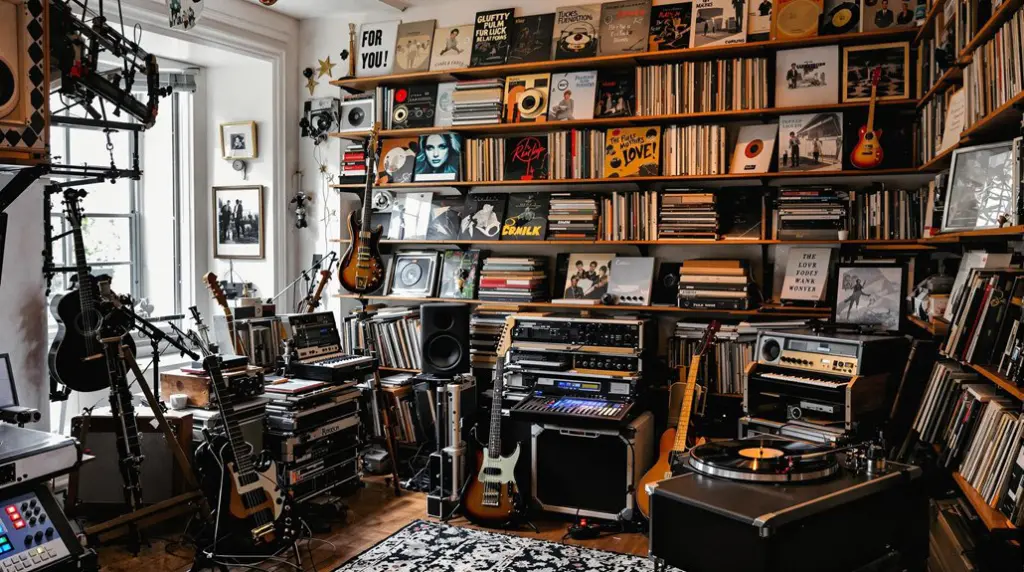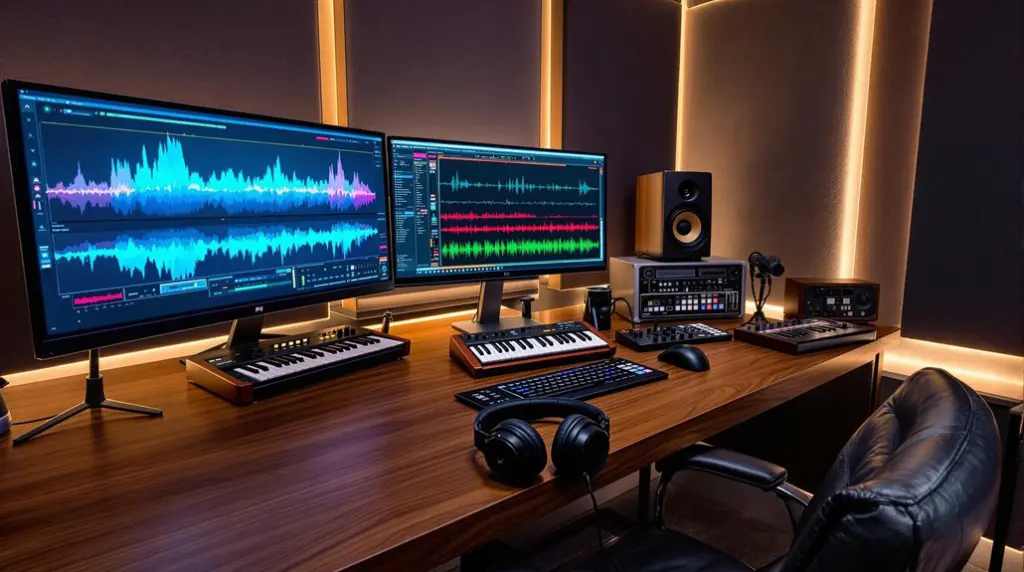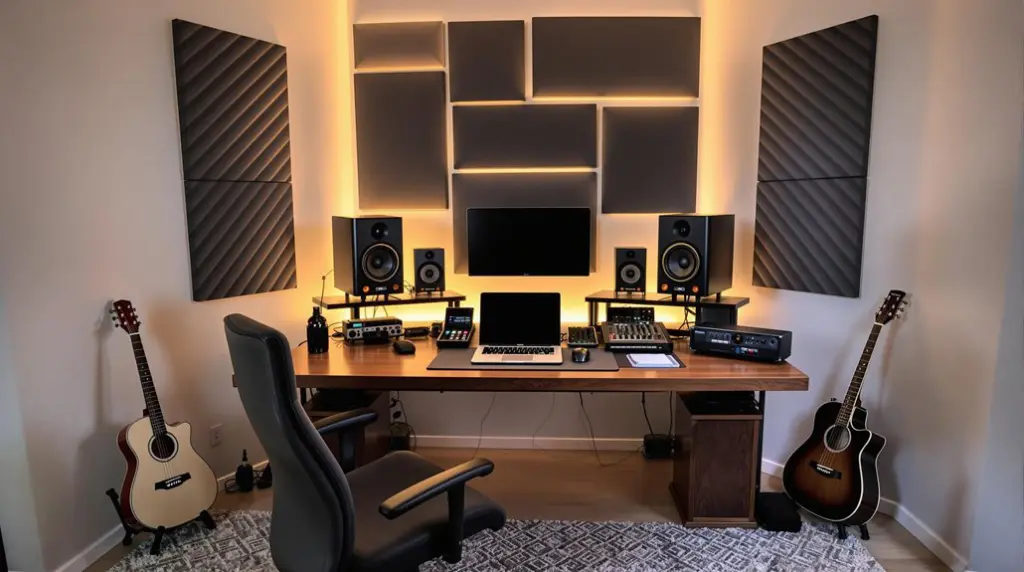Plate reverb is an artificial reverberation effect that uses a suspended metal plate to create sound. When you introduce audio signals, a transducer converts them into vibrations on the plate, producing a smooth, bright tonal quality. Contact microphones capture the reverberated sound, which you can customize by adjusting parameters like decay time and damping. This type of reverb is particularly effective for enhancing vocals and snare drums, giving them clarity in any mix. With its unique metallic texture and long reverb tails, it adds depth. There’s much more to explore about its applications and techniques.
Key Takeaways
- Plate reverb is a synthetic effect that creates artificial reverberation using a suspended metal plate to enhance audio quality.
- It operates by converting audio signals into vibrations on the plate, producing a smooth and bright tonal quality.
- The sound is captured by contact microphones, allowing for customizable parameters like decay time and pre-delay.
- Known for its long reverb tails, plate reverb adds a distinct metallic texture and clarity to vocals and snare drums.
- Popular in music production, it is often used to create atmospheric textures and enrich the overall sound of tracks.
Definition of Plate Reverb
Plate reverb is a sophisticated synthetic effect that creates artificial reverberation through a suspended metal plate. This audio unit employs a transducer that converts an incoming audio signal into vibrations on the plate, allowing it to resonate and produce a distinctive reverb sound.
The resulting effect is captured by microphones, offering a smooth and bright tonal quality that enhances the audio without introducing harshness. Unlike natural reverb, plate reverb provides a controlled, consistent sound, making it ideal for various applications, particularly in enhancing vocals and snare drums.
The EMT 140 is a notable example of this technology, celebrated for its lush reverberation characteristics that have made it a staple in professional audio production since its inception in the 1950s.
Historical Context
Plate reverb emerged in the 1950s as a compact alternative to traditional echo chambers, pioneered by the EMT 140 model.
Its distinctive sound quickly became essential in music production, particularly for enhancing vocals and snare drums.
While digital technology in the 1970s shifted focus away from analog methods, recent advancements in software emulation have revived interest in plate reverb‘s unique sonic characteristics.
Invention of Plate Reverb
During the 1950s, a significant innovation emerged in the field of audio production: the invention of plate reverb. This technology provided a compact solution for reverb effects, offering a practical alternative to larger echo chambers.
The EMT 140, introduced in 1957, was the first commercially successful plate reverb unit, revolutionizing the way studios approached reverb. Its ability to create a dense, warm sound distinguished it from natural reverberation, making it a favorite among engineers and producers.
The unique character of plate reverb contributed to its classic sound, which became integral to many recordings. Although digital reverb shifted focus in the 1970s, the resurgence of interest in plate reverb highlights its enduring appeal and sonic qualities.
Evolution of Digital Emulation
As the audio industry embraced new technologies, the late 20th century saw a shift toward digital solutions for reverb effects.
Initially, early digital reverbs of the 1970s struggled to match the natural warmth of plate reverb units like the EMT 140.
However, the advent of digital audio workstations (DAWs) in the 1990s transformed this environment. You now had access to software emulations that replicated the lush sonic character of plate reverb, offering audio engineers an affordable option for synthetic reverb.
Modern digital emulations, such as Soundtoys Little Plate and UAD EMT 140, faithfully capture the brightness and smooth decay inherent in physical units.
This resurgence aligns with contemporary music production aesthetics, emphasizing the ethereal quality that plate reverb brings to mixes.
Mechanism of Operation
When sound is introduced to a plate reverb system, a large metal plate, suspended under tension with springs, vibrates to create a rich reverberation effect. This mechanism of operation begins with a transducer that converts the audio signal into vibrations transmitted to the plate. The vibrations are then captured by contact microphones attached to the plate, which pick up the unique reverberated sound. You can adjust the output signal to control parameters like decay time, pre-delay, and damping, allowing for customization of the reverb effect.
| Parameter | Description | Effect on Sound |
|---|---|---|
| Decay Time | Duration of the reverb effect | Longer decay = more sustain |
| Pre-Delay | Time before reverb onset | Creates space in sound |
| Damping | Absorption of high frequencies | Warmer sound with less edge |
Sound Characteristics
When you use plate reverb, you’ll notice its bright and splashy sound that enhances the clarity of melodic instruments and vocals. This smooth tonal quality comes from closely spaced echoes, which lack the natural realism found in other reverb types. The result is a distinct metallic texture that adds an ethereal quality to your mix. Additionally, plate reverb is known for producing long reverb tails, creating expansive soundscapes that elevate the overall listening experience.
Bright and Splashy Sound
Plate reverb delivers a bright and splashy sound that stands out in various audio productions. By utilizing a suspended metal plate to create vibrations in response to audio signals, it emphasizes higher frequencies. This results in plate reverb sounds that enhance vocal clarity and presence, effectively adding a metallic sheen to darker mixes or instruments.
The close spacing of echoes creates a smooth texture, making early reflections less distinguishable, which contributes to its unique, dense sound profile. When applied creatively, this reverb adds depth and a larger-than-life resonance, particularly benefiting acoustic guitars and atmospheric textures in genres that embrace a dreamy, ethereal quality.
This distinctive tonal quality uplifts the overall mix, offering a lush, surreal listening experience.
Smooth Tonal Quality
Although often considered a synthetic effect, the smooth tonal quality of plate reverb plays an essential role in shaping the overall character of audio recordings.
This audio effect is particularly effective for enhancing high-midrange frequencies, making it an ideal choice for vocals and melodic instruments.
The resulting sound is characterized by:
- A lush, rich texture without harshness
- Brightening darker mixes through metallic resonance
- A distinct, atmospheric mix when used subtly
Lacks Natural Realism
While the smooth tonal quality of plate reverb enhances recordings, it’s important to acknowledge its limitations in natural realism.
Unlike natural reverb found in acoustic environments, plate reverb exhibits a synthetic nature that often introduces a metallic quality. This quality can detract from the authenticity listeners expect, especially in genres requiring a more genuine sound.
In addition, the closely spaced early reflections within plate reverb create a uniform sound, lacking the intricate patterns typical of natural reverberation. While this controlled ambience can offer an appealing, otherworldly vibe, it may not accurately reflect the acoustics of real spaces.
Ultimately, while plate reverb has its charm, its synthetic characteristics can limit its effectiveness in achieving true realism.
Applications in Music
Reverb serves as an essential tool in music production, and plate reverb stands out for its specific applications across various genres. Mixing engineers often utilize plate reverb to enhance the sonic environment of various sound sources, elevating the overall mix quality.
Here are some key applications in music:
- Vocals: It enhances clarity and presence, allowing vocals to stand out without harshness.
- Snare Drums: Provides a bright, punchy sound that cuts through dense mixes, especially in rock and pop.
- Atmospheric Textures: Ideal for slow-tempo ballads, it creates emotional depth and tension.
Plate reverb’s unique tonal characteristics also brighten darker mixes, making instruments like guitars and keyboards feel ethereal, perfect for classic country and holiday music. Additionally, its decay time can be finely tuned to maintain clarity while enriching the overall sound.
Synthetic vs. Realistic Reverb
When you consider reverb in music production, it’s essential to distinguish between synthetic and realistic types.
Synthetic reverb, like plate reverb, offers a controlled brightness that enhances clarity, while realistic reverb aims to mirror the complexities of actual environments. Understanding these characteristics allows you to choose the right reverb for your specific sound design needs. Additionally, knowing the differences in reverb types can help you select the most suitable effect for your desired sound.
Synthetic Reverb Characteristics
Synthetic reverb, such as plate reverb, provides a controlled method of simulating environmental reflections, yet it often lacks the intricate realism found in natural acoustics.
While room reverbs capture unique space characteristics, synthetic types of reverb offer a more uniform and bright sound.
Here are key characteristics of synthetic reverb:
- Enhanced Presence: Subtle plate reverb can uplift vocals and percussive elements, adding an iconic sound to your mix.
- Psychoacoustic Clarity: The artificial construction creates an illusion of depth that can be appealing in modern music production.
- Creative Flexibility: Using plate reverb allows for unique tonal manipulation, often adding color and brightness to tracks.
In essence, synthetic reverb serves as a powerful tool for sound design, despite its less authentic nature.
Realistic Reverb Applications
While you may appreciate the lush soundscapes created by synthetic reverb, understanding the applications of realistic reverb is essential for achieving a natural sonic quality.
Realistic reverb, designed to mimic the acoustics of a physical space like an echo chamber, enhances recordings by providing an authentic feel. It helps your tracks sound great in contexts where naturalness is paramount.
In contrast to synthetic options like plate reverb, realistic reverb may lack some brightness and sparkle but excels in replicating real-world environments.
Choosing between synthetic and realistic reverb depends on your desired effect. Blending both can yield unique auditory experiences, utilizing the strengths of each to create a balanced and immersive mix that captures the essence of your sound.
Mixing Techniques
To achieve a polished mix with plate reverb, you must carefully consider various parameters that influence its impact on the overall sound. Start by adjusting the decay time to guarantee it complements your track without overwhelming other elements.
Additionally, utilize pre-delay settings to create essential space between the original sound and the reverb.
Here are some key techniques to keep in mind:
- Apply damping to high frequencies to prevent excessive brightness that can detract from your mix.
- Consider combining plate reverb with other reverb types for a richer sound.
- Use automation to dynamically control reverb levels throughout the track, enhancing listener engagement.
- Remember that balancing dry and wet signals is crucial for maintaining clarity and depth in your mix.
Recommended Tools and Plugins
When it comes to implementing plate reverb in your mixes, selecting the right tools and plugins can greatly improve the quality of your sound.
For authentic emulations, consider popular plugins like Soundtoys Little Plate and UAD EMT 140, both revered for their high-quality recreations of classic recordings.
If you prefer customization, iZotope’s Neoverb allows you to blend various reverb types, including plate.
The PCM92 plugin is another versatile choice, known for achieving a range of reverb effects, while Altiverb7 excels in capturing real spaces to emulate plate characteristics.
Finally, SP2016 provides that classic plate reverb sound with added warmth, making it ideal for enhancing vocals and snare drums.
Additionally, plugins like Valhalla DSP VintageVerb offer extensive customization options, allowing for unique reverb effects that can enhance your mixes with classic hardware reverb nuances.
These recommended tools will boost your mixes considerably.
Creative Uses and Tips
Although plate reverb is renowned for its lush sound, using it creatively can enhance your mixes even further. To achieve a balanced audio signal, consider these tips:
- Damping: Apply damping to control excessive brightness, ensuring your mix remains smooth without overwhelming elements.
- Layering: Combine plate reverb with different types of reverb, like room or hall, to create a rich sense of space and depth, avoiding a synthetic feel.
- Pre-delay: Adjust pre-delay settings to separate the dry signal from the reverb effect, enhancing clarity and providing a sense of distance.
Additionally, predelay settings allow you to fine-tune the timing of your reverb, ensuring the initial sound remains distinct. Utilizing software emulations of plate reverb, such as Soundtoys Little Plate, gives you the flexibility to experiment with parameters for unique, enchanting results in your digital reverb applications.
Exploring Other Reverb Types
Exploring the diverse world of reverb types expands your mixing toolkit, allowing you to tailor the spatial characteristics of your sound. Each reverb type serves unique reverb uses:
| Reverb Type | Characteristics |
|---|---|
| Hall Reverb | Long decay times, ideal for orchestral sounds |
| Chamber Reverb | Lush and clear; versatile without muddiness |
| Spring Reverb | Bright, vintage sound; perfect for guitar tracks |
| Convolution Reverb | Captures real spaces using impulse responses |
| Digital Reverb | Flexible algorithms for simulating various environments |
From plate reverbs to spring reverb, understanding these options enables you to craft the desired ambiance. Utilizing various reverb techniques can greatly enhance your mixes, whether you’re enriching a mix or adding character, each type offers distinct benefits for your productions.
Frequently Asked Questions
What Are Plate Reverbs Best For?
Plate reverbs excel at vocal enhancement, adding clarity and presence. They create instrument depth, enriching mixes for live performance and studio production. Additionally, they craft ambient soundscapes, providing an ethereal quality that enhances overall musical texture.
Did the Beatles Use Plate Reverb?
Yes, you’ll find that The Beatles’ recording techniques prominently featured plate reverb effects at Abbey Road studio. Their innovative sound design enhanced vocal processing methods, contributing to the lush, immersive quality of their iconic tracks.
What Is the Most Famous Plate Reverb?
The most famous plate reverb is the EMT 140, known for its smooth, warm sound. Artists prefer it for its lush characteristics, and modern applications include digital emulations by famous brands, enhancing recordings across genres.
What Is the Difference Between Spring Reverb and Plate Reverb?
When comparing spring reverb characteristics to plate reverb applications, you’ll notice that plate reverb offers a warm, lush sound quality, while spring reverb’s brighter tones suit genres needing vintage resonance, reflecting their distinct historical development.
Conclusion
To conclude, plate reverb serves as a valuable tool for adding depth and texture to audio productions. Its unique mechanism, which simulates the natural decay of sound, allows for distinct sonic characteristics that enhance music. By understanding its applications and incorporating effective mixing techniques, you can achieve a polished sound. Experimenting with various tools and creative tips will further maximize its potential, ensuring that plate reverb remains a staple in your audio toolkit.




